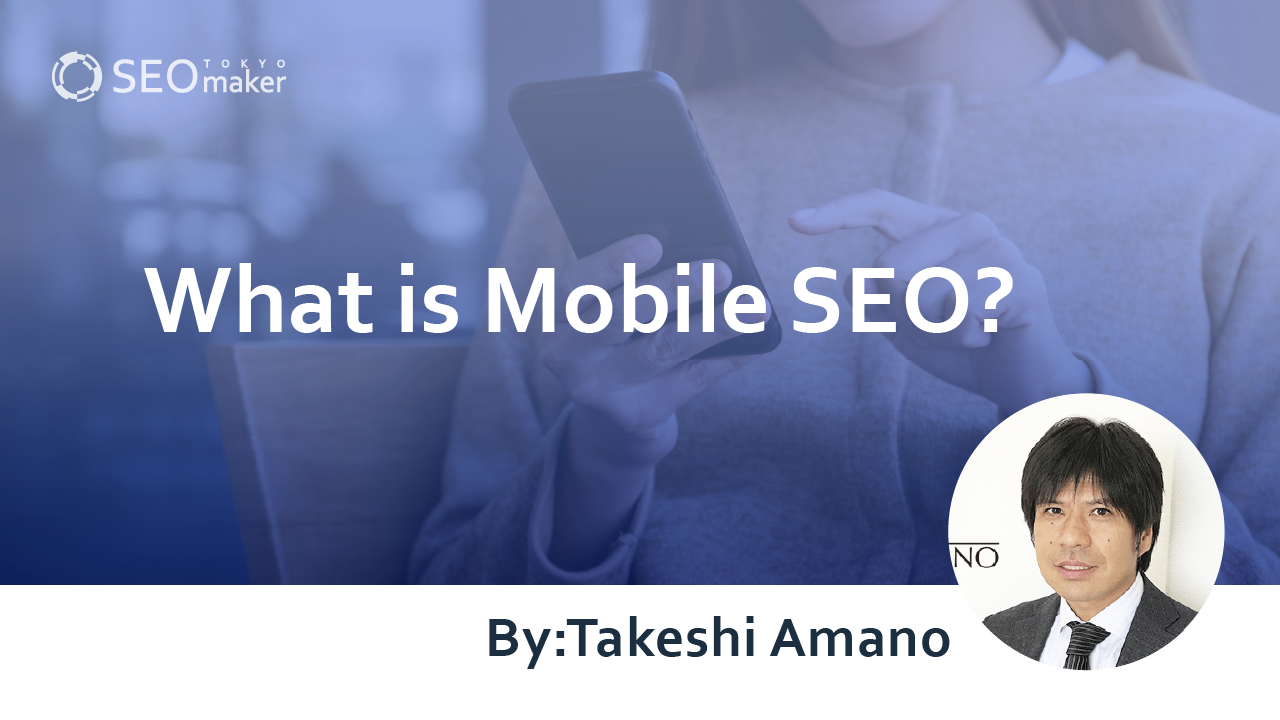What is Mobile SEO? : Explaining Methods for Smartphone SEO
contents

In recent years, using the internet on mobile devices such as smartphones has become the norm. Under these circumstances, it is essential for businesses to display content correctly on mobile devices and provide a user-friendly website.
Search engines like Google highly value mobile-friendly websites, so implementing SEO strategies tailored for mobile is crucial. This guide will delve into mobile SEO in detail.
What is Mobile SEO?
Mobile SEO involves optimizing your website for searches performed on mobile devices, including smartphones. While websites are accessed through various devices like PCs, tablets, and smartphones, it’s particularly important to focus strategies on smartphones.
The prevalence of smartphones has been remarkable. In 2010, only about 10% of households owned a smartphone, but by 2012 this had risen to about half. By 2020, over 80% of households had a smartphone. As smartphone ownership has increased, so has internet usage, with some sites reporting that over 90% of their users are smartphone users, making the push for mobile SEO imperative.
Why You Should Optimize for Mobile
As the use of smartphones expands, more people are accessing websites via mobile devices. Websites originally designed for desktops often encounter issues on mobile, such as small text, buttons that are too close together making them hard to press, and small images.
Difficulties in viewing and reading content lead to user stress, which can increase the site’s bounce rate. Google’s fundamental approach emphasizes a user-first philosophy, so websites that cause high user stress, and consequently have high bounce rates, are at a disadvantage when it comes to improving search rankings.
In web marketing, SEO is a critical strategy for reducing acquisition costs while increasing inquiries, making mobile adaptation essential.
Mobile First Index (MFI)
While similar in name, Mobile SEO and the Mobile First Index (MFI) have entirely different meanings.
Mobile SEO refers to the practice of implementing SEO strategies optimized for mobile devices, particularly smartphones, to improve search rankings. On the other hand, the Mobile First Index refers to Google’s rule of prioritizing the mobile version of a site when evaluating for indexing.
Originally, Google assessed desktop versions of websites. However, in response to the rapid increase in mobile users, Google shifted to the Mobile First Index in 2018. Websites that have a significant quality disparity between their desktop and mobile versions or are missing information on the mobile site may lose out in evaluations. Given that mobile users now outnumber desktop users, this shift is considered a natural progression.
Benefits of Mobile SEO
Following the Mobile-Friendly Update in April 2015, websites that are optimized for smartphones are now ranked higher in search results than those that are not when searches are made on mobile devices.
With mobile searches now being the norm, and considering that 70-80% of search traffic comes from mobile devices, strategically optimizing for mobile can naturally lead to higher traffic.
However, the reasons for adopting mobile optimization go beyond passive necessity. The failure to implement mobile SEO strategies can jeopardize a site’s survival. Actively improving the UI/UX for mobile users can lead to higher rankings and increased revenue.
Types of Mobile Sites
When creating a mobile site, there are generally three approaches
- -Responsive Web Design
- -Dynamic Serving
- -Separate (creating separate sites for PC and mobile)
However, dynamic serving and separate setups require handling two versions of content for publishing and updates, which can be cumbersome. Unless there is a specific reason, it is advisable to use Responsive Web Design.
Responsive Web Design: No changes to URL, No changes to HTML
Dynamic Serving: No changes to URL, Changes to HTML
Separate Sites: Changes to URL, Changes to HTML
Responsive Web Design
Responsive Web Design involves delivering the same HTML to all devices using a single URL. Despite varying screen sizes across devices, adjustments can be made using CSS, preventing the issue of duplicate content. This is the most recommended approach because of its simplicity and efficiency.
Dynamic Serving
Dynamic Serving allows for the delivery of different HTML to each device under the same URL. This means you need to create separate HTML for the PC site and the mobile site, and potentially a third one for tablets if they are treated distinctly.
This method allows for tailored content delivery to each device type, potentially speeding up load times as mobile sites won’t need to download desktop-specific images. Managing the HTTP header via .htaccess makes implementation straightforward, but managing more pages does increase the workload, which is a significant drawback.
Separate (Creating separate sites for PC and mobile)
Separate involves delivering optimized pages for both PC and mobile versions under different URLs. Although this can result in duplicate content, using canonical and alternate settings can prevent negative SEO impacts.
However, having multiple URLs can complicate efforts to concentrate links when spreading content via social media or gathering inbound links, which is a considerable disadvantage. While older sites might use Separate setups, it is common to switch to Responsive Web Design during a site renewal due to these drawbacks.
Target Keyword Selection for Mobile SEO
In mobile SEO, selecting the right keywords is crucial. Proper keyword selection enables efficient attraction of potential customers. Here, we will discuss some key points for choosing keywords when implementing mobile SEO.
Utilizing Local Keywords
Users often search on their smartphones while on the move. Therefore, for mobile SEO, select local keywords. Local keywords include names of places, stores, branches, or stations. Creating pages that incorporate these keywords can increase access via smartphones.
Specific Keywords
Compared to PC users, mobile users tend to use more specific keywords in their searches. This means that the search intent of users is usually clear, and pages should be created to align with this intent.
Optimizing for Voice Search
Many users on mobile devices like smartphones and tablets use voice search, which utilizes voice recognition technology for searching without the need to type. Well-known examples include Google Assistant and Siri. In mobile SEO, it is crucial to accommodate voice search. For instance, selecting keywords in a conversational tone or those that mimic spoken language can be effective.
Optimizing User Experience for Mobile SEO
User experience refers to the overall impression and ease of use of the interface when a user visits a website. Mobile SEO requires a unique approach to user experience optimization compared to desktop devices.
Focus on the following three areas.
- -Use readable text sizes
- -Make links easy to press
- -Improve loading speeds
Using Readable Text Sizes
Text is a crucial element of content. If the text is too small, it can be difficult to read, leading Google to classify the website as “not mobile-friendly.”
Google recommends a font size of 16px, while Android suggests 18px (iOS does not specify, but it is recommended to use at least 11px).
Therefore, aim for a minimum of 16px for body text, and ensure that captions and supplementary texts do not become too small.
It is also important to implement viewport settings to make the text more readable. Refer to Google’s basics of responsive web design for improvements.
Making Links Easy to Press
Even if there are no difficulties using a mouse cursor on a desktop screen, links and buttons can be too close together and hard to press on mobile devices. Fingers vary in size, and a layout that makes links difficult to press or prone to errors is considered “not mobile-friendly.”
Increase the length of anchor text and the space between buttons to make the site easier to navigate.
improving Loading Speed
Loading speed is critical on both desktop and mobile, but it is especially crucial on mobile devices. Delays in loading can directly lead to user abandonment.
According to Google, if loading takes more than 3 seconds, 53% of users will leave, and according to NEILPATEL, 40% will leave if it takes more than 3 seconds. While there is some variation in these statistics, there’s no doubt that even a few seconds of delay can lead to lost opportunities.
To improve loading speed, there are two main methods
- Data Minimization
- Utilizing Cache
Data minimization can be easily implemented through image compression, gzip compression, and compressing HTML and CSS. As for caching, depending on the setup, if you are using WordPress, it can be easily configured using plugins.
Link Building Strategies for Mobile SEO
In mobile SEO, it’s important to be mindful of certain aspects when building links. Here, I’ll share some key points and considerations.
Linking to Mobile-Friendly Websites
Since users are accessing sites via mobile devices, make sure to link to mobile-friendly websites. If the links lead to PC-only sites, it can decrease user convenience. Search engines also favor mobile-friendly websites, so linking to them can positively impact your mobile SEO efforts.
Linking to Local Sites
Searches on mobile devices, such as smartphones, often seek local information. Therefore, consider linking to local websites, such as those of local businesses, to enhance user convenience. Linking to reputable local sites strengthens your website’s mobile SEO.
Considerations for Mobile SEO
Here are some important considerations for your mobile SEO strategy:
Using the Same Content on PC and Mobile
It’s common to see sites that create a PC page and then a mobile page, but often the content is not the same. It is crucial that the information available does not differ by device as this can lead to a lower evaluation from Google.
Ensure that PC and mobile pages have consistent content. If updating both versions becomes too cumbersome, consider switching to a responsive design.
With responsive design, one HTML can adjust to display correctly across multiple devices. Although transitioning to responsive design can be labor-intensive, it is recommended today. Considering the effort involved in future maintenance, it’s advisable to adopt responsive design early.
Be aware that even with responsive design, some sites choose not to display certain content on mobile or deliberately impair visibility through css. Generally, these practices are discouraged.
If content is displayed on the PC version but hidden on mobile, it might be unnecessary. Consider removing such content from the PC site as well.
Redirecting PC and Mobile Pages
If you are not using responsive design and have separate pages for PC and mobile, redirects are necessary for search engine crawlers.
Specifically, when a crawler for PC pages accesses a mobile page, it should redirect to the PC site, and vice versa for mobile crawlers accessing PC pages. This ensures that users and crawlers are directed to the appropriate version of the site depending on the device being used.
Canonical tags, short for “canonicalization,” serve the purpose of conveying the correct URL to search engines. When both a PC page and a mobile page exist, search engines may perceive them as two separate pages, causing evaluation dispersion and potentially leading to a drop in search ranking.
To prevent this, it’s advisable to implement canonical tags alongside alternate tags. “Alternate” signifies an alternative, making it clear that the page is an alternate version of the canonical (primary) page.
Typically, applying canonical tags to PC pages and alternate tags to mobile pages resolves this issue.
However, even if your site is responsive and the URLs for PC and mobile pages match, it’s still recommended to apply canonical tags to all pages.
Checking Mobile-Friendliness
Once mobile-friendly settings are in place, it’s important to verify whether they’ve been accurately communicated to search engines.
There are several ways to do this, but generally, you can use either of the following tools provided by Google.
-Mobile-Friendly Test
-Google Search Console
Mobile-Friendly Test
The Mobile-Friendly Test is a tool provided by Google where you can easily check whether a site is mobile-friendly by entering its URL or code.
Additionally, Google used to offer a free tool called “Test My Site,” which not only confirmed mobile compatibility but also provided suggestions for improving speed. However, this service has been discontinued. For checking mobile speed and improvement points, you can use Google’s Page Speed Insights, another free tool provided by Google.
Google Search Console
If you want to verify your entire site, use the “Mobile Usability” feature in Google Search Console. It allows you to check which URLs are not usable on mobile devices (In the above image, there are two items) and provides specific recommendations for fixing them.
Frequently Asked Questions about Mobile SEO (Q&A)
Here, we will address common questions about mobile SEO.
Q: What are the key points in mobile SEO?
A: In mobile SEO, crucial points include optimizing loading speed, images, and selecting keywords tailored for mobile devices. Additionally, depending on the industry, focusing on local SEO is also important.
Q: What are the benefits of implementing mobile SEO for businesses?
A: Implementing mobile SEO leads to higher rankings in mobile searches, resulting in increased traffic and contributing to conversions and brand building.
Q: What skills are required to implement mobile SEO?
A: Essential skills for implementing mobile SEO include knowledge of SEO, data analysis skills to measure results, and programming skills to convert to responsive design.
Q: What is AMP?
A: AMP stands for “Accelerated Mobile Pages,” a technology for speeding up web pages, which is also beneficial for mobile SEO.
Summary
Mobile SEO involves optimizing SEO for searches conducted on mobile devices, primarily smartphones. While creating mobile pages can address this, it requires attention to detail, such as text and button sizes, and may involve structural changes like responsive web design. Mobile optimization is crucial in today’s landscape, where mobile users outnumber PC users, making it a vital SEO strategy. As mobile dominance continues to grow, allocating budget and resources to mobile optimization is increasingly important.










![What is a Description? Explaining the Meaning, Writing Style, and Changing Word Count – [2023 Edition]](https://www.switchitmaker2.com/en/wp-content/uploads/2024/09/what-is-description.webp)










